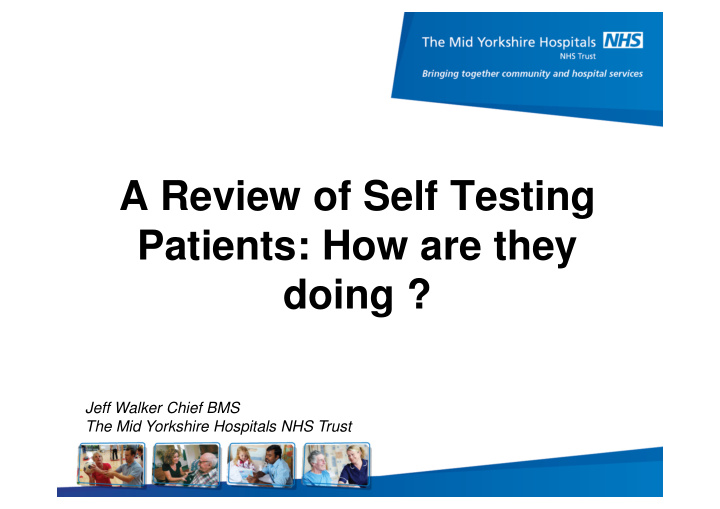



A Review of Self Testing Patients: How are they doing ? Jeff Walker Chief BMS The Mid Yorkshire Hospitals NHS Trust
2010 Dawn user Group
Dose calculated and returned by SMS INR into DAWN system £10,080.00 would buy an interface to provide SMS and Email return Dose calculated and returned verbally by automatically along with next test phone Reminders. Please make cheques payable to Jeff Walker. Return Cumulative Patient Record via Royal Mail
How Does it Work • Initial contact • First appointment to discus contract and how system works • Patient gains GP agreement (or not) • Three further training appointments
Why Self test ? • Reduce workload • Improve compliance • Sharing responsibility of care • Committed to provide a service • Listen to Users of that service • Cos Jeff says so!!
The Contract • Patients responsibilities • Do as you’re told… (or else) • Lab responsibilities • Nothing changes really • GP responsibilities • Sign up that the patient is capable • No commitment to prescribe test strips
Benefits? • Improve compliance • Develop partnership with staff • Patient satisfaction • Staff satisfaction
What Did We Achieve? • Better control – Anecdotally yes – audits to come (next years talk?) • Better relationship with patients • Patient satisfaction – Compliments…. • Staff satisfaction – Due to relationship improvements much better
What did we learn? • Management tools only tell half the story • There will be resistance • Keep it small to start with • It’s hard work
2013 Dawn user Group
Early Adopters • Building site workers • The Travelling retired • Children
Who’s in the Study • Patients who have been on warfarin for a minimum of six moths prior to starting self testing and have self tested for six months. • Four patients who had at least six months prior to self testing and between three and six months post self testing. • A total of 35 patients just under 50% of our self testers.
Individual Patients % Time In Range - Non Self Patient number Sex % Time In Range - Self Test Difference Test 1 Fem 64.57 31.38 33.19 2 Fem 83.3 70 13.3 3 Fem 68.08 38.37 29.71 4 Male 92.91 63.28 29.63 5 Male 75.51 47.97 27.54 6 Fem 78.9 51.99 26.91 7 Male 73.2 46.3 26.9 8 Male 85.05 58.46 26.59 9 Male 96.8 71.03 25.77 10 Fem 91.44 66.05 25.39 11 Male 100 74.83 25.17 12 Fem 100 75.44 24.56 13 Fem 61.86 37.76 24.1 14 Fem 84.12 60.25 23.87 15 Fem 87.69 64.26 23.43 16 Male 84.16 61.18 22.98 17 Male 77.3 56.3 21 18 Male 89.63 70.6 19.03 19 Male 94.5 76.18 18.32 20 Male 86.4 68.83 17.57 21 Fem 84.35 67.63 16.72 22 Male 92.89 78 14.89 23 Male 73.69 59.7 13.99 24 Fem 84.13 72.71 11.42 25 Fem 78.46 67.52 10.94 26 Fem 89.86 79.39 10.47 27 Fem 94.17 86.05 8.12 28 Male 85.31 77.52 7.79 29 Fem 64.37 56.73 7.64 30 Male 80 72.44 7.56 31 Fem 76.18 69.89 6.29 32 Male 84.54 79 5.54 33 Male 82.34 77.95 4.39 34 Fem 58 55.94 2.06 35 Male 54.6 79.45 -24.85
Self Test Data • Every patient bar one showed an improved Time in Therapeutic Range (TTR). • The average improvement in TTR was 18% (16.8 including the none improver). • There was a 22% improvement in TTR amongst the poorly controlled, with a TTR below 65% prior to PST. • There was a 15% improvement in TTR amongst the well controlled patients, with a TTR above 65% prior to PST. • 80% of patients who were poorly controlled, prior to PST (TTR below 65%) moved into the well controlled category after PST.
Clinical Outcomes 5% improvement in TTR in therapeutic range across UK anticoagulation clinics would prevent 400-500 strokes per year . ( Connolly SJ, Circulation 2008;118:2029-2037 ) This equates to a saving of nearly £5-6 million ( www.commissioningboard.nhs.uk/2012/05/24).
WHAT? • 5% improvement in TTR in therapeutic range across UK anticoagulation clinics would prevent 400-500 strokes per year (£5-6 million) • The average improvement of our patients TTR was: 16.8%
Take Care • When extrapolating our data great care must be taken as our patient group is very selective however we did achieve an average improvement of at least 16.8 %.
Patient Satisfaction 1. Since starting self testing I feel my INR is more stable. 82.4% agree 2. Since starting self testing I feel more in control of my anticoagulant therapy. 94.1% agree 3. I would recommend self testing to other anticoagulant patients. 100% agree 4. Self testing has been beneficial to my life style. 100% agree
Why Self test ? • Reduce workload not for us but reduced phlebotomy demands. • Improve compliance yes. • Sharing responsibility of care yes . • Committed to provide a service we always were and always will be.
Why Self test ? • Listen to Users of that service we did and we acted. • Cos Jeff says so!! not a very good reason and no-one ever listens anyway.
Future The future of Anticoagulant Control is Self Testing/Management
Thank You Questions?
Recommend
More recommend